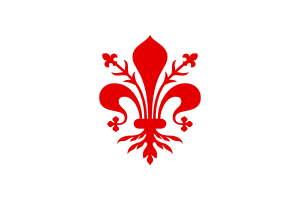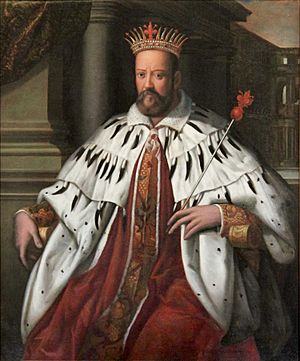History of Tuscany facts for kids
Tuscany is a beautiful region in Italy. It gets its name from its very first inhabitants, the Etruscans, who lived there even before the Roman Empire. For many centuries, Rome ruled Tuscany.
Later, during the Middle Ages, Tuscany faced many invasions. But in the amazing Renaissance period, it became a leader in art, science, and new ideas for Europe. After that, it became a powerful state called a grand duchy. In the late 1700s, Napoleonic France took over Tuscany. Finally, in the 1800s, Tuscany became part of modern Italy.
Contents
Early Peoples in Tuscany
Long, long ago, in the middle and late Bronze Age (around 1400–1150 BC), people of the Apennine culture lived in Tuscany. They traded with ancient civilizations like the Minoans and Mycenaeans from the Aegean Sea.
Later, around 1100-900 BC, the Proto-Villanovan culture appeared. Then, at the start of the Iron Age (around 900–700 BC), the Villanovan culture took over. This culture is seen as the earliest stage of the Etruscan civilization. During this time, small chiefdoms formed, and then city-states began to grow, much like in ancient Greece.
The Etruscan Civilization
The Etruscans were the first major civilization in Tuscany. They built roads, developed farming and mining, and created amazing art. The Etruscans lived in a region called Etruria. Their civilization grew between the Arno River and Tiber River from the 900s BC, reaching its peak in the 600s and 500s BC.
Over time, the Etruscans lost land to other groups like the Greeks, Carthaginians, and Gauls. By the 1st century BC, the Romans had taken over all of Etruria. Even though the Greeks saw the Etruscans as different, Greek and Roman cultures greatly influenced them. Eventually, the Etruscan culture slowly blended into the Roman way of life.
Roman Rule in Tuscany
After taking over Etruria, Rome built important cities like Lucca, Pisa, Siena, and Florence. The Romans brought new technologies and improvements to the area. They extended roads, built aqueducts (channels for water) and sewers, and constructed many public and private buildings. This brought a long period of peace to the region.
However, the Roman Empire in the West fell apart in the 400s AD. Tuscany was then taken over by groups like the Goths. In the 500s, the Longobards arrived and made Lucca the capital of their Duchy of Tuscia.
Tuscany in the Middle Ages
After the Western Roman Empire fell, Tuscany was ruled by the Ostrogoths and then the Byzantine Empire. In 569, the Lombards conquered the region and created the Duchy of Tuscia, with its capital in Lucca. When Charlemagne defeated the Lombard kingdom, Tuscany became a county, and then a march (a border territory).
In the 1000s, the Attoni family from Canossa became powerful rulers in Tuscany. Matilda of Canossa was a very famous member of this family. During this time, many castles, abbeys, and monasteries were built in Tuscany. The main towns also started to grow again and became independent communes (self-governing cities).
Lucca was actually the first commune in Italy. Other important ones included Arezzo, Florence, Siena, and Pisa. These cities often fought with each other. In the south of Tuscany, the Aldobrandeschi family ruled as feudal lords.
Pilgrims traveling on the Via Francigena (a famous road between Rome and France) brought wealth to Tuscany. The need for food and shelter for these travelers helped communities grow around churches and inns.
In the 1000s, Pisa became the most powerful city. It built a large trading empire across the Mediterranean Sea and played a key role in the Crusades. Florence, Siena, and Lucca became important centers for banking, with branches in other European countries. Lucca was also known for its silk production.
Pisa's power began to decline in the 1200s and 1300s after it was defeated by Genoa in the Battle of Meloria. By the early 1400s, Florence had become the most important city in Tuscany, and in Italy. It was also the cultural heart of the region. Siena was Florence's only remaining rival in Tuscany.
Republics in Tuscany
For centuries, several cities in Tuscany were independent republics, meaning they were governed by elected officials rather than a king.
Republic of Pisa (c. 1000–1406)
From its beginning until 1189, the Republic of Pisa was led by elected consuls. After 1190, it adopted a Podestà as its head of state. Even after a popular revolt in 1254, the Podestà remained the most important leader.
Republic of Florence (1115–1434)
Before the powerful Medici family took control, Florence had different forms of republican government. In 1172, the Florentines elected their first Consuls. In 1207, they elected their first Podestà. In 1293, the republic elected its first Gonfaloniere of Justice, a special leader. Republican rule ended in 1434 when Cosimo de' Medici became the first powerful Lord of the city-state.
Republic of Siena (1125–1555)
After removing the bishop who governed the city, Siena elected consuls as its first leaders. In 1199, they elected their first Podestà. Later, the city was governed by members of the Republic's council. For a short time (1399 to 1404), Siena was even ruled by the Visconti of Milan. The republic finally lost its independence to the growing power of Florence.
Republic of Lucca (1160–1805)
The Republic of Lucca was special because it managed to stay independent much longer than other Tuscan cities, even into the modern era. It was one of the longest-lasting city-states in Italy. The republic was led by a Gonfaloniere, and its main governing bodies were the Great Council, the Minor Council, and the Council of the Elders.
The Renaissance Period
In the 1400s, Florence greatly expanded its power in Tuscany. It took over Arezzo in 1384, bought Pisa in 1405, and gained control of Livorno in 1421, making it Florence's main port.
In Florence, the powerful Medici family began to dominate the republic from 1434 onwards. Leaders like Cosimo the Elder, Piero the Gouty, and Lorenzo the Magnificent ruled without official titles, but they were the true leaders. They oversaw the incredible Florentine Renaissance, a time of great artistic and scientific achievement.
There was a brief return to a republic from 1494 to 1512, led first by Girolamo Savonarola and then by Piero Soderini. But in 1512, Cardinal Giovanni de' Medici (who later became Pope Leo X) retook the city with Spanish help. Florence was then controlled by leaders appointed by the Pope until 1527, when citizens declared the republic again. However, an army besieged the city, and it was taken again in 1530. At this point, Pope Clement VII and Emperor Charles V appointed Alessandro de' Medici as the first official hereditary ruler.
Siena was not fully joined with Tuscany until 1555. During the 1400s, Siena had its own "Sienese Renaissance" with a more traditional style. Lucca remained an independent Republic until 1847, when its people chose to join the Grand Duchy of Tuscany. Piombino was another small state that was not part of the Grand Duchy, but was influenced by both Spain and Tuscany.
The Grand Duchy of Tuscany
For most of the 1500s, the Medici family ruled Florence and Tuscany very well. They expanded the state by adding Siena. The Medici were great supporters of science and the arts, which thrived during their rule. Tuscany became a more united state, rather than just a region dominated by Florence.
Over time, Tuscany changed. The wool industry, which had been very important, declined. While the silk industry grew a bit, overall, industry in Florence began to shrink in the 1600s. People started investing more in land instead of businesses. By the early 1700s, Tuscany was not as strong, partly due to some less effective Grand Dukes.
When the House of Medici family line ended, Francis I, a relative, became the Grand Duke. This placed Tuscany under the rule of the House of Habsburg-Lorraine.
One important ruler was Leopold I (known in Italy as Pietro Leopoldo). He was a progressive reformer. He ended the last parts of serfdom (a system where people were tied to the land), encouraged trade and industry, and improved the government. During his long rule, Tuscany became one of the most successful states in Italy. On November 30, 1786, he made Tuscany the first country to officially stop using the death penalty.
In 1801, Napoleon Bonaparte removed Ferdinand III from power. Tuscany became the Kingdom of Etruria for a short time. In 1807, Napoleon's France took over Tuscany completely. In 1809, Napoleon gave his sister, Elisa Bonaparte, the honorary title of Grand Duchess of Tuscany. After Napoleon's defeat in 1814, Ferdinand III became Grand Duke again. However, in 1815, the Congress of Vienna separated the Duchy of Lucca from Tuscany, giving it to another family. Lucca was finally reunited with Tuscany in 1847.
Part of Italy
In 1861, Tuscany officially became part of modern Italy. Florence even served as Italy's capital from 1865 to 1871, before Rome became the capital.
See also
 In Spanish: Historia de Toscana para niños
In Spanish: Historia de Toscana para niños
- Grand Duchy of Tuscany
- Grand Prince of Tuscany
- Grand Princesses of Tuscany
- History of Florence
- History of Siena
- House of Habsburg-Lorraine
- House of Medici
- Kingdom of Etruria
- List of Italian State Archives in Tuscany
- List of rulers of Tuscany
- Lucca
- Pisa



